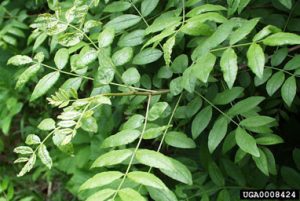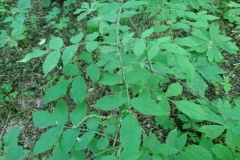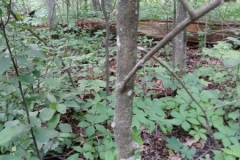Prickly Ash and Other Thorny Issues
If you are like me, prickly ash is not your favorite native tree or shrub. It may very well be a problem on your property because of its sharp thorns and the dense thickets it creates. Controlling this mid-story tree and its many shoots is my second biggest challenge.
The thorns on prickly ash stems can cause painful puncture wounds that can become infected. The dense clones they create shade out native grasses and wildflowers reducing biological diversity.
To their credit, prickly ash are host plants for the larvae of at least three important butterfly species; Thoas swallowtail (Papilio thoas), giant swallowtail (P. cresphontes), and spicebush swallowtail (P. troilus). Bobwhites, Red-eyed Vireos and Chipmunks are among the animals that eat the fruit.
Getting Control
Some trees are dead once their trunk is cut. This is true for most evergreen conifers. Other trees, such as boxelder will readily sprout shoots from the cut stump creating a shrub-like mass of stems. Prickly ash has yet another strategy. When their trunk is cut the wood appears bright yellow and smells like citronella. Once cut, growth nodes in its roots sprout new stems from the ground, often multiple new stems where originally there was only one. These new stems can be some distance from the original trunk. For this reason, prickly ash cannot be managed simply by cutting trunks. Adding a systemic herbicide applied to the cut stump, immediately after the trunk is cut, will kill the root system preventing re-sprouting.
Grazing is another way to limit the spread of prickly ash. Unfortunately, many breeds of cattle avoid prickly ash. Scottish highland cattle, however, seem to find it irresistible. Goats too will make a quick meal of young sprouts, as well as leaves as high as they can reach. A healthy grazing regime means moving the herd frequently to prevent both overgrazing and soil compaction.

photo credit: Paul Wray, Iowa State University.
Winning Combination
Like many invasive plants, prickly ash are most effectively managed using an integrated management strategy. That means combining several different tactics. The first step in managing prickly ash is to cut the trunks and treat the stumps with a herbicide containing the chemical tryclopyr. Product names include Element 3A and Element 4, as well as Garlon 3A and Garlon 4. Stack and burn the cut trunks and branches taking particular care to ensure seed heads burn to prevent new plants from sprouting. The second step is to put the treated area into a prescribed burn regimen. Burning the area every 2-3 years kills any stems that were not killed by the herbicide, as well as prickly ash seed that is left in the soil.
Even if a small number of plants remain, their numbers will be small enough to prevent prickly ash from crowding out other beneficial plants.


